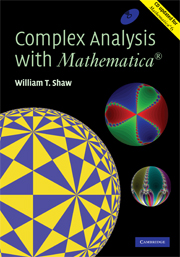Book contents
- Frontmatter
- Contents
- Preface
- 1 Why you need complex numbers
- 2 Complex algebra and geometry
- 3 Cubics, quartics and visualization of complex roots
- 4 Newton—Raphson iteration and complex fractals
- 5 A complex view of the real logistic map
- 6 The Mandelbrot set
- 7 Symmetric chaos in the complex plane
- 8 Complex functions
- 9 Sequences, series and power series
- 10 Complex differentiation
- 11 Paths and complex integration
- 12 Cauchy's theorem
- 13 Cauchy's integral formula and its remarkable consequences
- 14 Laurent series, zeroes, singularities and residues
- 15 Residue calculus: integration, summation and the argument principle
- 16 Conformal mapping I: simple mappings and Möbius transforms
- 17 Fourier transforms
- 18 Laplace transforms
- 19 Elementary applications to two-dimensional physics
- 20 Numerical transform techniques
- 21 Conformal mapping II: the Schwarz—Christoffel mapping
- 22 Tiling the Euclidean and hyperbolic planes
- 23 Physics in three and four dimensions I
- 24 Physics in three and four dimensions II
- Bibliograpy
- Index
18 - Laplace transforms
Published online by Cambridge University Press: 05 August 2014
- Frontmatter
- Contents
- Preface
- 1 Why you need complex numbers
- 2 Complex algebra and geometry
- 3 Cubics, quartics and visualization of complex roots
- 4 Newton—Raphson iteration and complex fractals
- 5 A complex view of the real logistic map
- 6 The Mandelbrot set
- 7 Symmetric chaos in the complex plane
- 8 Complex functions
- 9 Sequences, series and power series
- 10 Complex differentiation
- 11 Paths and complex integration
- 12 Cauchy's theorem
- 13 Cauchy's integral formula and its remarkable consequences
- 14 Laurent series, zeroes, singularities and residues
- 15 Residue calculus: integration, summation and the argument principle
- 16 Conformal mapping I: simple mappings and Möbius transforms
- 17 Fourier transforms
- 18 Laplace transforms
- 19 Elementary applications to two-dimensional physics
- 20 Numerical transform techniques
- 21 Conformal mapping II: the Schwarz—Christoffel mapping
- 22 Tiling the Euclidean and hyperbolic planes
- 23 Physics in three and four dimensions I
- 24 Physics in three and four dimensions II
- Bibliograpy
- Index
Summary
Introduction
There is a transform that is closely related to a special case of the Fourier transform, known as the Laplace transform. While the Laplace transform is very similar, historically it has come to have a separate identity, and one can often find separate tables of the two sets of transforms. Furthermore, it is very appropriate to make a separate assessment of both its inversion, and its applications to differential equations. In the latter context, Laplace transforms are particularly useful when dealing with ODEs and PDEs defined on a half-space – in this setting its differential properties are slightly different from the Fourier transform due to the influence of the boundary.
The goal of this chapter is to define the Laplace transform and explain the basic results and links to complex variable theory. It should be appreciated that there is an extensive knowledge base of known transforms and their inverses. Sadly, many of the excellent books of tables of transforms are old and hard to find if not actually out of print. You might like to check if your library has copies of the old works by Erdelyi. One notable exception is the extraordinarily comprehensive series of books by Prudnikov, Brychkov and Marichev, in which volumes 4 and 5 (Prudnikov et al, 1998, 2002) give tables of transforms and their inverses.
- Type
- Chapter
- Information
- Complex Analysis with MATHEMATICA® , pp. 381 - 400Publisher: Cambridge University PressPrint publication year: 2006



